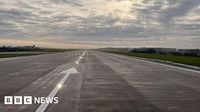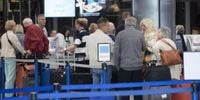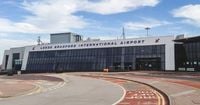Leeds Bradford Airport, a crucial travel hub in Yorkshire, was thrust into chaos overnight as an unforeseen runway issue forced a sudden closure, leaving thousands of travelers scrambling for answers and alternative arrangements. The disruption, which began late on Friday, October 24, 2025, rippled across the UK and Europe, impacting flights, stranding passengers, and testing the airport’s commitment to safety and customer care.
The trouble started around 9pm, when airport officials announced via their website that an “unforeseen issue with the runway” had necessitated an immediate halt to all operations. “Due to an unforeseen issue with the runway, we have had to take the decision to close the airport until the morning. Customers are advised to check with their airline for the most up-to-date information regarding their flight,” a spokesperson stated, according to the Manchester Evening News. The statement stressed, “We are working to resolve the disruption as soon as possible, the safety and comfort of the passengers travelling through our terminal is our number one priority. Our team is on the ground in the terminal to answer any customer queries regarding departures.”
The sudden closure caused a domino effect. Flights scheduled to depart or arrive at Leeds Bradford were either cancelled or rerouted to other UK airports—including Newcastle, Manchester, Birmingham, Liverpool, Stansted, Humberside, and East Midlands—according to The Mirror. Passengers returning from destinations such as Spain, France, The Netherlands, and Turkey found themselves landing far from home, some facing journeys of over two hours to reach their intended destination. For example, two Jet2.com flights from Turkey, due to arrive in the early hours, were diverted to Birmingham, which is more than 130 miles from Leeds Bradford Airport.
The airport, which typically operates flights 24 hours a day thanks to planning permission granted in 1994, was eerily quiet. The designated night-time flight period, from 11pm to 7am, usually sees only the quietest jets permitted to operate, but on this night, there was silence except for the hum of repair teams racing against the clock. A total of 14 scheduled arrivals late Friday and early Saturday were diverted, while outbound passengers queued—some outside in heavy rain—hoping for updates and shelter. Footage circulated online showed weary travelers taking cover under umbrellas, a stark reminder of the unpredictable nature of air travel.
As the night wore on, updates from the airport trickled in. At 10pm, the website reiterated the closure and the ongoing efforts to resolve the situation. By midnight, repair teams were still hard at work, with hopes pinned on a 6am reopening. “Repair teams have completed their work, and we expect the runway to reopen from 06:00. Unless your airline advises otherwise, please arrive as planned for your flight,” read a later update, as reported by The Mirror. The airport also apologized for the inconvenience, noting that customer care teams were “working hard but are experiencing high volumes” and responding on a first-come, first-served basis.
Travelers were not left entirely in the lurch. Airport staff were visible throughout the terminal, fielding questions and trying to ease the frustration of disrupted journeys. The airport’s social media and website urged passengers to “check with their airline for the most up-to-date information regarding their flight,” and reassured them that “the safety and comfort of the passengers travelling through our terminal is our number one priority.”
Despite the best efforts of staff, the uncertainty led to a flurry of confusion. The first outbound flight scheduled after the closure was a Jet2 service to Heraklion, Crete, set for 5:25am on Saturday, October 25. However, not all flights were so lucky. A 6:20am KLM flight to Amsterdam was cancelled outright, and passengers on that route were told to contact their airline for alternative arrangements. Meanwhile, the online arrival board listed numerous cancellations and diversions, with only a Wizz Air Hungary flight from Gdansk at 7:10am and a Ryanair service from Dublin expected to arrive on schedule.
As dawn approached, the mood at Leeds Bradford Airport shifted from anxious waiting to cautious optimism. At 6:00am, airport officials confirmed that the runway had been repaired and normal operations were resuming, though they warned that “some delays and disruptions may still occur.” Passengers were advised, “Please arrive as planned unless your airline has advised otherwise.” The airport also provided practical support for those affected, offering to cancel unused car park, fast track, or lounge bookings, and promising assistance for overstays in their car parks.
Throughout the ordeal, the airport maintained a consistent message: safety first. The exact nature of the runway issue was never disclosed, with officials referring only to an “unforeseen issue.” According to BBC News, a spokesperson emphasized, “The safety and comfort of the passengers travelling through our terminal is our number one priority. Our team is on the ground in the terminal to answer any customer queries regarding departures.”
The impact of the closure was felt far beyond Yorkshire. With dozens of flights departing from Leeds Bradford each day, the disruption placed additional strain on neighboring airports and left many travelers facing lengthy, unexpected journeys. For some, the experience was a test of patience and adaptability; for others, it was a stark reminder of the complexities and vulnerabilities inherent in modern air travel.
As normal operations resumed, the airport signaled that no further updates were expected, and the focus shifted to clearing the backlog and restoring routine. While the precise cause of the runway issue remains a mystery, the episode underscored the importance of rapid response, clear communication, and passenger support during moments of crisis. For the thousands affected, it was a night they won’t soon forget—and for Leeds Bradford Airport, a challenge met with determination and a renewed commitment to keeping travelers safe and informed, no matter what the skies may bring.


